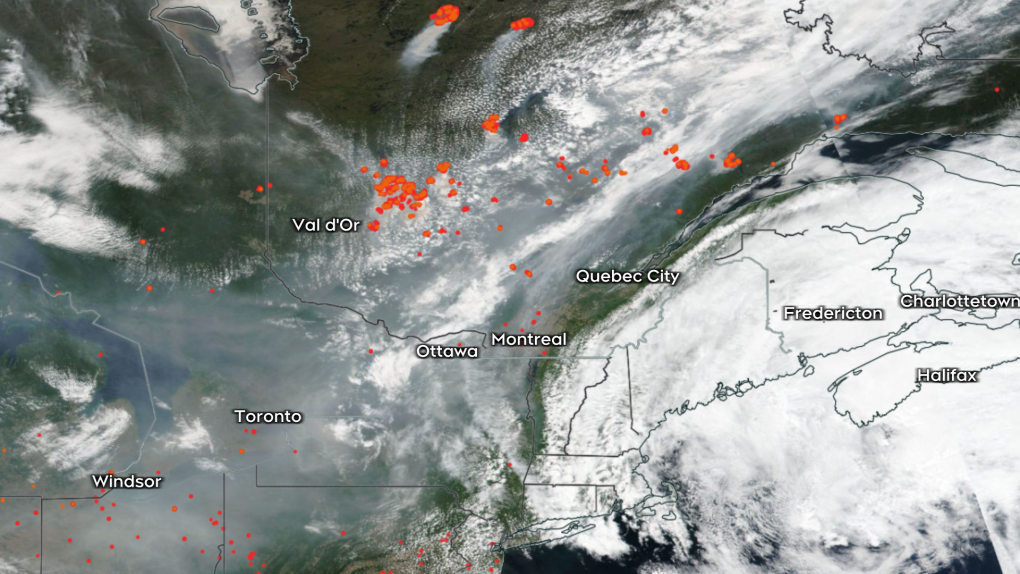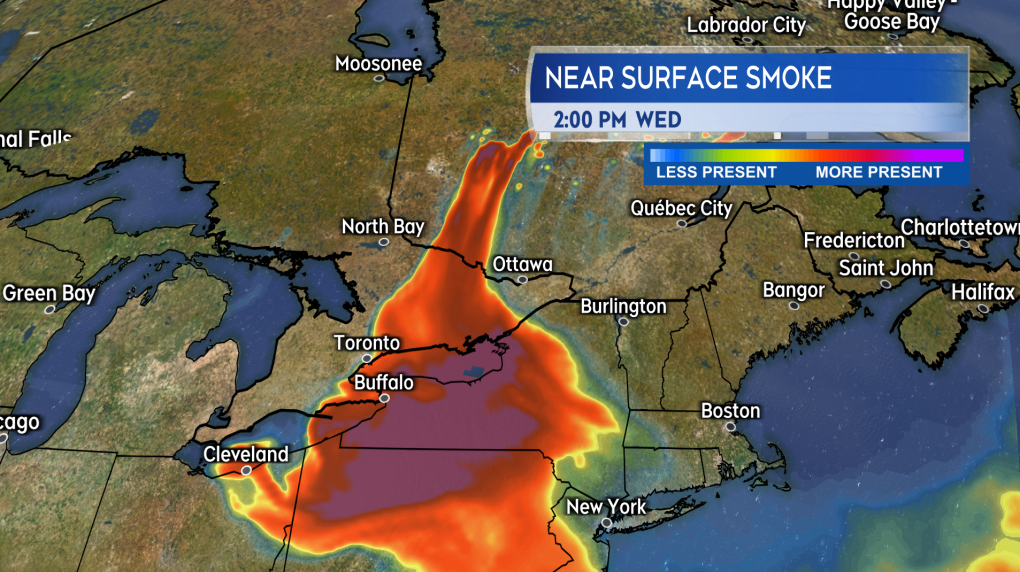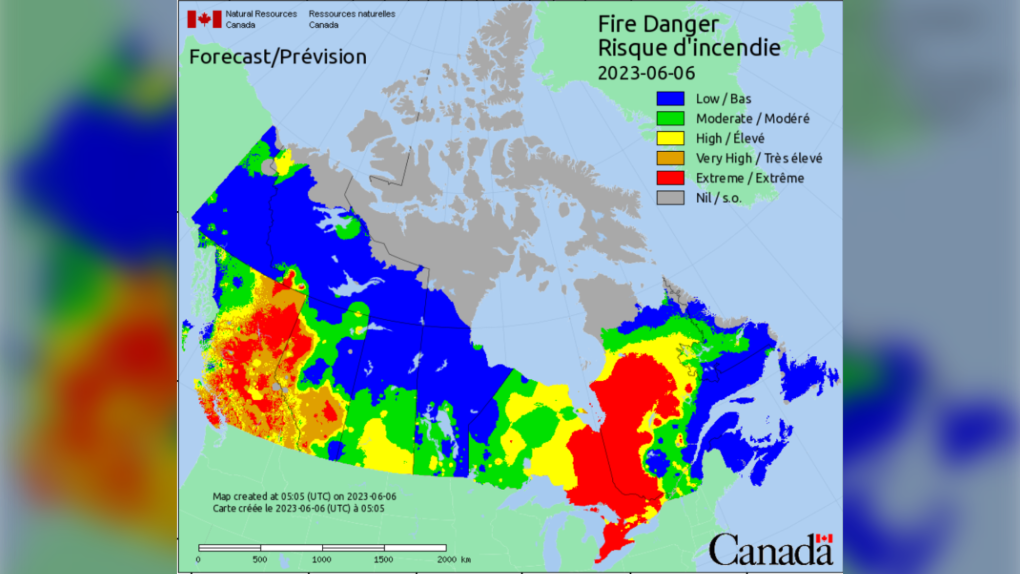Air quality statements remain in effect in N.S., wildfire smoke impacting Ontario and Quebec
 NASA satellite imagery showing haze, smoke plumes
NASA satellite imagery showing haze, smoke plumes
Air quality statements remain in effect for parts of Nova Scotia and wildfire smoke continues to impact large areas of Ontario and Quebec Tuesday.
In what has become an all-too-familiar sight this spring, smoke from wildfires is visible from space via satellites.
The following image is from June 5 and shows wildfire smoke in the grey haze. Clouds are the brighter white spots. Red spots denote wildfire locations, and thick smoke plumes off the fires in northern Quebec are easily spotted.
Some of those wildfires were likely ignited by lightning from widespread thunderstorms in Quebec on Thursday and Friday of last week.
Forecasts call for a very active wildfire season across country.
Wildfire smoke continues to drift north to south, out of Quebec and into Ontario today. Air quality levels in Ottawa are at a score of 10+ — very high risk.
Air Quality Statements are in effect for much of Quebec and a good portion of eastern and southern Ontario. Those most vulnerable to wildfire smoke include people with lung disease such as asthma, heart disease, older adults, children, pregnant people, and people who work outdoors.
So far there is little indication that smoke from the Quebec wildfires will move into the Maritimes over the next few days. Modelling for Wednesday shows much of the lower smoke has moved south towards Ontario and the northeastern United States. Air quality statements do remain in effect for Shelburne County in Nova Scotia due to the proximity of the Barrington Lake wildfire.
 Modelling for near surface smoke show that for Wednesday it is expected to be mainly blown to the south of Quebec and not towards the Maritimes.The Maritimes has continued to pick up a significant amount of rain over the last 24 hours.
Modelling for near surface smoke show that for Wednesday it is expected to be mainly blown to the south of Quebec and not towards the Maritimes.The Maritimes has continued to pick up a significant amount of rain over the last 24 hours.
Rainfall reports for New Brunswick ranged from five to 35 mm Monday morning to Tuesday morning. Nova Scotia saw between 20 to 80 millimetres of rain during that period of time. Prince Edward Island also had a reported rainfall of just over 30 mm to just over 60 mm.
 A greatly improved fire danger index for the Maritimes. Now rated as low by Natural Resources Canada following days of rain.The prolonged period of wet and cool weather has reduced the wild fire danger index dramatically in the Maritimes.
A greatly improved fire danger index for the Maritimes. Now rated as low by Natural Resources Canada following days of rain.The prolonged period of wet and cool weather has reduced the wild fire danger index dramatically in the Maritimes.
As of Tuesday Natural Resources Canada has the Maritimes in low risk for fire danger. A burn ban remains in place provincially for both Nova Scotia and Prince Edward Island.
New Brunswick is now open to burning of category one fires, which include campfires.
CTVNews.ca Top Stories

Annual inflation rate increased to 2.9% in March
Statistics Canada will release its consumer price index for March on inflation this morning.
Freeland to present 2024 federal budget, promising billions in new spending
Canadians will learn Tuesday the entirety of the federal Liberal government's new spending plans, and how they intend to pay for them, when Deputy Prime Minister and Finance Minister Chrystia Freeland tables the 2024 federal budget.
Ontario woman charged almost $7,000 for 20-minute taxi ride abroad
An Ontario woman was shocked to find she’d been charged nearly $7,000 after unknowingly using an unauthorized taxi company while on vacation in January.
Worker seriously injured after fall at Montreal Olympic Stadium
A man is fighting for his life after falling about 30 feet in an air duct at Montreal's Olympic Stadium on Monday, authorities say.
Tim Hortons launches pizza nationally to 'stretch the brand' to afternoon, night
Tim Hortons is launching flatbread pizzas nationally in a bid to pick up more afternoon and evening customers.
Despite weather glitch, the Paris Olympics flame is lit at the Greek cradle of ancient games
The flame that is to burn at the Paris Olympics was kindled Tuesday at the site of the ancient games in southern Greece.
Step inside Emma Roberts' sumptuous L.A. home
While many celebrity homes look less than lived-in, ranging from spotless minimal to ostentatiously palatial, actor Emma Roberts' Hollywood Hills home is made for curling up with a good book -- or several -- with warm tones, comfortable couches, and antique curiosities in each room (also, a lagoon-style pool in the backyard for summer reads).
NASA confirms mystery object that crashed through roof of Florida home came from space station
NASA confirmed Monday that a mystery object that crashed through the roof of a Florida home last month was a chunk of space junk from equipment discarded at the International Space Station.
Hazard ahead: Are cuts at Tesla a warning sign for the EV market in Canada?
Tesla has hit a series of roadblocks, including increased competition and declining sales. The company announced Monday it is slashing 10 per cent of its global workforce.






























